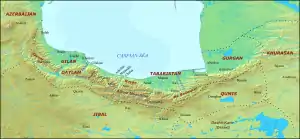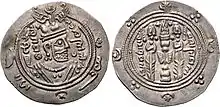Tabaristan
Tabaristan or Tabarestan (Persian: طبرستان, romanized: Ṭabarestān, or Mazanderani: تبرستون, romanized: Tabarestun, ultimately from Middle Persian: ![]() , Tapur(i)stān), was the name applied to a mountainous region located in the Caspian coast of northern Iran. It corresponded to the present-day province of Mazandaran, which became the predominant name of the area from the 11th-century onwards.[1]
, Tapur(i)stān), was the name applied to a mountainous region located in the Caspian coast of northern Iran. It corresponded to the present-day province of Mazandaran, which became the predominant name of the area from the 11th-century onwards.[1]

Pre-Islamic era
Tabaristan was named after the Tapurians, who had been deported there from Parthia by the Parthian king Phraates I (r. 176–171 BC).[2][3] At the advent of the Sasanians, the region, along with Gilan and Daylam, was part of the Padishkhwargar kingdom of king Gushnasp, who is mentioned in the Letter of Tansar. He submitted to the first Sasanian King of Kings (shahanshah) Ardashir I (r. 224–242 AD) after being guaranteed to keep his kingdom.[4][5] His line would continue ruling Padishkhwargar until the second reign of Kavad I (r. 488–496, 498–531), who removed the dynasty from power and appointed his son Kawus in its stead.[6] Under the Sasanians, Tabaristan enjoyed considerable autonomy.[1] They most likely left most of the affairs to the locals. The mint signature of "AM" is generally presumed to be an abbreviation for the Amul, the main city of the region. The last known Sasanian monarch to have minted coins with the signature was queen Boran (r. 630–630, 631–632).[7]
Islamic era
Dabuyid rule

In the 640s, the Dabuyid prince Gil Gavbara (r. 642–660), who was a great-grandson of shahanshah Jamasp (r. 496–498/9), conquered all of Daylam and Gilan and planned on extending his conquests to Tabaristan. Its governor, Adhar Valash, requested the aid of (shahanshah) Yazdegerd III (r. 632–651). Being unable to supress the revolt, Yazdegerd III instead acknowledged Gil Gavbara as the ruler of the regions, presumably to deter him from creating an independent realm. Gil Gavbara was given the titles of Padashwārgarshāh (shah of Padishkhwargar) and "Ispahbad of Khorasan", possibly indicating Dabuyid rule in eastern Iran. Gil Gavbara maintained the independence of his realm during the Arab invasion of Iran, which had resulted in the collapse of the Sasanian Empire.[8][9]
His son Baduspan I was granted control over Ruyan (a district that encompassed the western part of Tabaristan) in 665, thus forming the Baduspanid dynasty, which would rule the region until the 1590s.[10] Rule in the mountains of Tabaristan was maintained by two Dabuyid vassal kingdoms, the Qarinvandids and Bavandids. In 716, the Dabuyid ruler Farrukhan the Great (r. 712–728) successfully contained a large-scale invasion by the Umayyad general Yazid ibn al-Muhallab.[9] Farrukhan's son and successor Dadhburzmihr may have temporarily lost control of Tabaristan to the Arabs, as indicated by his lack of coinage. However, this may also mean the Dabuyids lacked funds to circulate throughout their realm.[11] The last Dabuyid ruler Khurshid managed to safeguard his realm against the Umayyads, but after its replacement by the Abbasid Caliphate, he was finally defeated in 760.[12] Tabaristan was subsequently made a regular province of the caliphate, ruled from Amul by an Arab governor, although the local dynasties of the Bavandids, Qarinvandids, the Zarmihrids and Baduspanids, formerly subject to the Dabuyids, continued to control the mountainous interior as tributary vassals of the Abbasid government.[13][14][15] These rulers were largely if not completely autonomous.[15]
Caliphate rule
The second Abbasid governor of Tabaristan, Khalid ibn Barmak,[16] had attempted to build towns and befriend the Qarinvand ruler Wandad Hurmuzd (r. 765–809) in order to increase Abbasid influence there. After he left the region, however, the Bavandid ruler Sharwin I (r. 772–817) destroyed his constructions. Although Wandad Hurmuzd and Sharwin had reassured their pledge to the caliph al-Mahdi in 781, they mounted a threatening anti-Muslim rebellion with the Masmughan of Miyanrud two years later. According to local accounts, the rebels massacred all the Muslim inhabitants of Tabaristan in one day. The modern historian Wilferd Madelung considers it exaggerated, and suggests that the massacres only took place in the highlands and segments of the lowlands that the rebels where able to penetrate. The rebels were initially successful, defeating the Muslim forces and their leaders. This alarmed al-Mahdi, who in 783/4 sent his son Musa with "a huge army and equipment such as no one previously had been equipped, to Gurgan to direct the war against Wandad Hurmuzd and Sharwin, the two lords of Tabaristan."[17]
The following year, a force of 40,000 soldiers under Sa'id al-Harashi finally defeated the rebels. Wandad Hurmuzd was wounded and captured, but he was soon pardoned and allowed to return to his lands.
References
- Webb 2018.
- Brunner 1983, p. 766.
- Minorsky, Bosworth & Vasmer 1991, p. 935.
- Brunner 1983, p. 765.
- Felix & Madelung 1995, pp. 342–347.
- Pourshariati 2008, p. 288.
- Malek 2017, pp. 101–102.
- Yavari 2020.
- Madelung 1993, pp. 541–544.
- Ghereghlou 2018.
- Malek 2017, p. 104.
- Malek 2017, p. 105.
- Madelung 1975, pp. 200–201.
- Rekaya 1986, pp. 68–70.
- Malek 2017, p. 106.
- Malek 2017, pp. 105–107.
- Madelung 1975, p. 200.
Sources
- Barthold, Vasilii Vladimirovich (2015). "Chapter XV. Gīlān And Māzandarān". An Historical Geography of Iran. Princeton University Press. pp. 230–242. ISBN 9781400853229. JSTOR j.ctt7zvv3z. (registration required)
- Bosworth, C. E. (1968). "The Political and Dynastic History of the Iranian World (A.D. 1000–1217)". In Boyle, John Andrew (ed.). The Cambridge History of Iran, Volume 5: The Saljuq and Mongol Periods. Cambridge: Cambridge University Press. ISBN 0-521-06936-X.
- Blois, F. C. de (2000). "Tansar". In Bearman, P. J.; Bianquis, Th.; Bosworth, C. E.; van Donzel, E. & Heinrichs, W. P. (eds.). The Encyclopaedia of Islam, New Edition, Volume X: T–U. Leiden: E. J. Brill. ISBN 978-90-04-11211-7.CS1 maint: ref=harv (link)
- Brunner, Christopher (1983). "Geographical and Administrative divisions: Settlements and Economy". In Yarshater, Ehsan (ed.). The Cambridge History of Iran, Volume 3(2): The Seleucid, Parthian and Sasanian Periods. Cambridge: Cambridge University Press. pp. 747–778. ISBN 0-521-24693-8.
- Felix, Wolfgang; Madelung, Wilferd (1995). "Deylamites". Encyclopaedia Iranica, Vol. VII, online edition, Fasc. 4. New York. pp. 342–347.
- Ghereghlou, Kioumars (2018). "Bādūsbānids". In Fleet, Kate; Krämer, Gudrun; Matringe, Denis; Nawas, John; Rowson, Everett (eds.). Encyclopaedia of Islam, THREE. Brill Online. ISSN 1873-9830.
- Madelung, W. (1975). "The Minor Dynasties of Northern Iran". In Frye, Richard N. (ed.). The Cambridge History of Iran, Volume 4: From the Arab Invasion to the Saljuqs. Cambridge: Cambridge University Press. pp. 198–249. ISBN 0-521-20093-8.
- Madelung, Wilfred (1993). "Dabuyids". Encyclopædia Iranica, Vol. VI, online edition, Fasc. 5. New York. pp. 541–544.
- Malek, Hodge Mehdi (1995). "The Dabuyid Isphabads of Tabaristan". The American Numismatic Society: 105–160.
- Malek, Hodge Mehdi (2017). "Tabaristān During the 'Abbāsid Period: The Overlapping Coinage of the Governors and Other Officials (144-178H)". In Faghfoury, Mostafa (ed.). Iranian Numismatic Studies. A Volume in Honor of Stephen Album. Lancaster and London: Classical Numismatic Group. pp. 101–126.
- Melville, Charles (2020). The Timurid Century: The Idea of Iran Vol.9. University of Cambridge, English: Bloomsbury Publishing. ISBN 9781838606152.
- Minorsky, Vladimir; Bosworth, C. E. & Vasmer, R (1991). "Māzandarān". In Bosworth, C. E.; van Donzel, E. & Pellat, Ch. (eds.). The Encyclopaedia of Islam, New Edition, Volume VI: Mahk–Mid. Leiden: E. J. Brill. ISBN 978-90-04-08112-3.CS1 maint: ref=harv (link)
- Minorsky, Vladimir (1995). "Rūyān". In Bosworth, C. E.; van Donzel, E.; Heinrichs, W. P. & Lecomte, G. (eds.). The Encyclopaedia of Islam, New Edition, Volume VIII: Ned–Sam. Leiden: E. J. Brill. ISBN 978-90-04-09834-3.CS1 maint: ref=harv (link)
- Pourshariati, Parvaneh (2008). Decline and Fall of the Sasanian Empire: The Sasanian-Parthian Confederacy and the Arab Conquest of Iran. I.B. Tauris. ISBN 978-1-84511-645-3.
- Rekaya, M. (1986). "Khurshīd". In Bosworth, C. E.; van Donzel, E.; Lewis, B. & Pellat, Ch. (eds.). The Encyclopaedia of Islam, New Edition, Volume V: Khe–Mahi. Leiden: E. J. Brill. pp. 68–70. ISBN 978-90-04-07819-2.
- Webb, Peter (2018). "Tabarestan". In Nicholson, Oliver (ed.). The Oxford Dictionary of Late Antiquity. Oxford: Oxford University Press. ISBN 978-0-19-866277-8.
- Yavari, Neguin (2020). "Dābūyids". In Fleet, Kate; Krämer, Gudrun; Matringe, Denis; Nawas, John; Rowson, Everett (eds.). Encyclopaedia of Islam, THREE. Brill Online. ISSN 1873-9830.